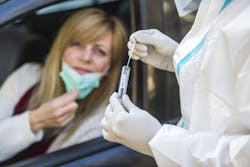On Jan. 19, Walgreens announced via a press release that it has released a new COVID-19 tracking tool. The tool, the Walgreens COVID-19 Index, is powered by testing data from Nashville, Tenn.-based Aegis Sciences Corporation. According to the release, the tracker is among the first to identify current and emerging variants in near real-time.
The release states that “New data from the Walgreens COVID-19 Index shows more than 95 percent of all positive COVID-19 cases are presumed to be the Omicron variant. The data reinforces the importance of vaccinations and testing in helping to mitigate the spread of COVID-19.”
That said, “Data captured in the Walgreens COVID-19 Index can track the spread of the Omicron variant within 24 to 48 hours, more quickly than other methods. In addition to a national view, data can be reviewed by state. The Walgreens COVID-19 Index is based on proprietary data from PCR testing services administered by Walgreens and performed by its testing partner Aegis Sciences.”
The release adds that based on data analyzed as of Jan. 18, insights from the Walgreens COVID-19 Index include:
- In the U.S., more than 95 percent of positive cases are presumed to be the Omicron variant
- The top states for COVID-19 positive rates (over 45 percent of those tested) are Alabama, Florida, Georgia, Mississippi, South Dakota, Nevada, and Texas
- The top states for confirmed Delta case frequency are Maine (43.5 percent), Kansas (36.5 percent), Iowa (29.2 percent), New Mexico (25.2 percent), Oklahoma (24.2 percent), Indiana (23.6 percent), and Utah (23.5 percent)
Matthew Hardison, Ph.D., senior vice president of lab operations at Aegis Sciences Corporation, was quoted in the release saying that “Data regarding spread of variants is important to our understanding of viral transmission and, as new variants emerge, it will be critical to continue to track this information quickly to predict which communities are most at risk. We are pleased to partner with Walgreens to provide testing, collaborate on data analysis and provide timely insights that can help health departments curtail the COVID-19 pandemic.”


